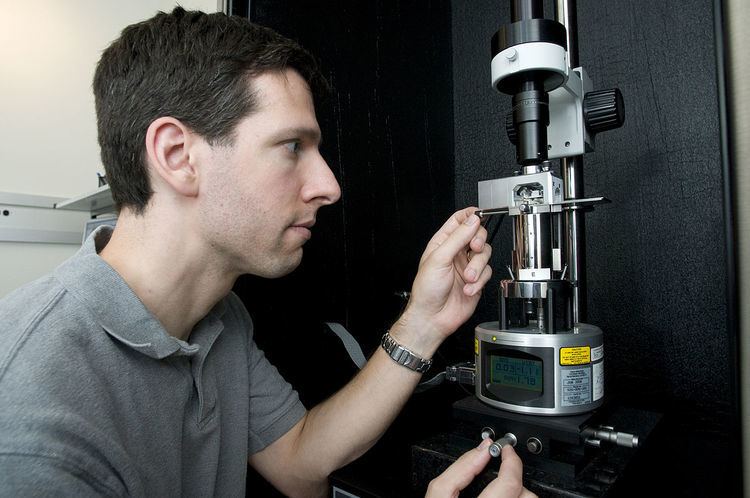 | ||
Observational error (or measurement error) is the difference between a measured value of quantity and its true value. In statistics, an error is not a "mistake". Variability is an inherent part of things being measured and of the measurement process.
Contents
Measurement errors can be divided into two components: random error and systematic error. Random errors are errors in measurement that lead to measurable values being inconsistent when repeated measures of a constant attribute or quantity are taken. Systematic errors are errors that are not determined by chance but are introduced by an inaccuracy (as of observation or measurement) inherent in the system. Systematic error may also refer to an error having a nonzero mean, so that its effect is not reduced when observations are averaged.
Overview
There are two types of measurement error: systematic errors and random errors.
A systematic error (an estimate of which is known as a measurement bias) is associated with the fact that a measured value contains an offset. In general, a systematic error, regarded as a quantity, is a component of error that remains constant or depends in a specific manner on some other quantity.
A random error is associated with the fact that when a measurement is repeated it will generally provide a measured value that is different from the previous value. It is random in that the next measured value cannot be predicted exactly from previous such values. (If a prediction were possible, allowance for the effect could be made.) In general, there can be a number of contributions to each type of error.
Science and experiments
When either randomness or uncertainty modeled by probability theory is attributed to such errors, they are "errors" in the sense in which that term is used in statistics; see errors and residuals in statistics.
Every time we repeat a measurement with a sensitive instrument, we obtain slightly different results. The common statistical model we use is that the error has two additive parts:
- systematic error which always occurs, with the same value, when we use the instrument in the same way and in the same case, and
- random error which may vary from observation to observation.
Systematic error is sometimes called statistical bias. It may often be reduced by very carefully standardized procedures. Part of the education in every science is how to use the standard instruments of the discipline.
The random error (or random variation) is due to factors which we cannot (or do not) control. It may be too expensive or we may be too ignorant of these factors to control them each time we measure. It may even be that whatever we are trying to measure is changing in time (see dynamic models), or is fundamentally probabilistic (as is the case in quantum mechanics — see Measurement in quantum mechanics). Random error often occurs when instruments are pushed to their limits. For example, it is common for digital balances to exhibit random error in their least significant digit. Three measurements of a single object might read something like 0.9111g, 0.9110g, and 0.9112g.
Systematic errors versus random errors
Measurement errors can be divided into two components: random error and systematic error.
Random error is always present in a measurement. It is caused by inherently unpredictable fluctuations in the readings of a measurement apparatus or in the experimenter's interpretation of the instrumental reading. Random errors show up as different results for ostensibly the same repeated measurement. They can be estimated by comparing multiple measurements, and reduced by averaging multiple measurements.
Systematic error, however, is predictable and typically constant or proportional to the true value. If the cause of the systematic error can be identified, then it usually can be eliminated. Systematic errors are caused by imperfect calibration of measurement instruments or imperfect methods of observation, or interference of the environment with the measurement process, and always affect the results of an experiment in a predictable direction. Incorrect zeroing of an instrument leading to a zero error is an example of systematic error in instrumentation.
The Performance Test Standard PTC 19.1-2005 “Test Uncertainty”, published by the American Society of Mechanical Engineers (ASME), discusses systematic and random errors in considerable detail. In fact, it conceptualizes its basic uncertainty categories in these terms.
Random errors lead to measurable values being inconsistent when repeated measures of a constant attribute or quantity are taken. The word random indicates that they are inherently unpredictable, and have null expected value, namely, they are scattered about the true value, and tend to have null arithmetic mean when a measurement is repeated several times with the same instrument. All measurements are prone to random error. Because random errors are reduced by re-measurement (making n times as many independent measurements will usually reduce random errors by a factor of √n), it is worth repeating an experiment until random errors are similar in size to systematic errors. Additional measurements will be of little benefit, because the overall error cannot be reduced below the systematic error.
Random error can be caused by unpredictable fluctuations in the readings of a measurement apparatus, or in the experimenter's interpretation of the instrumental reading; these fluctuations may be in part due to interference of the environment with the measurement process. The concept of random error is closely related to the concept of precision. The higher the precision of a measurement instrument, the smaller the variability (standard deviation) of the fluctuations in its readings.
Surveys
The term "observational error" is also sometimes used to refer to response errors and some other types of non-sampling error. In survey-type situations, these errors can be mistakes in the collection of data, including both the incorrect recording of a response and the correct recording of a respondent's inaccurate response. These sources of non-sampling error are discussed in Salant and Dillman (1995) and Bland and Altman (1996).
